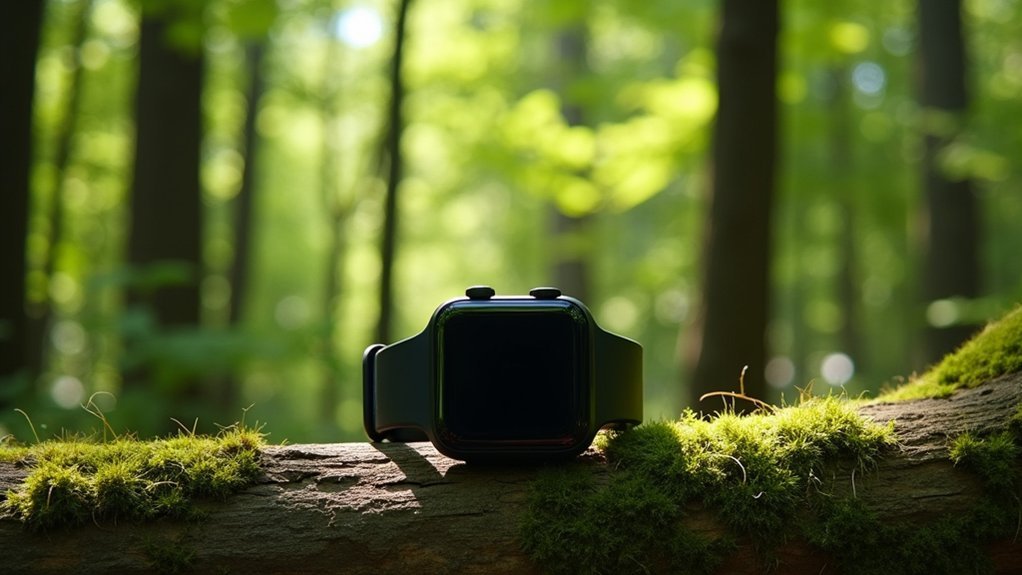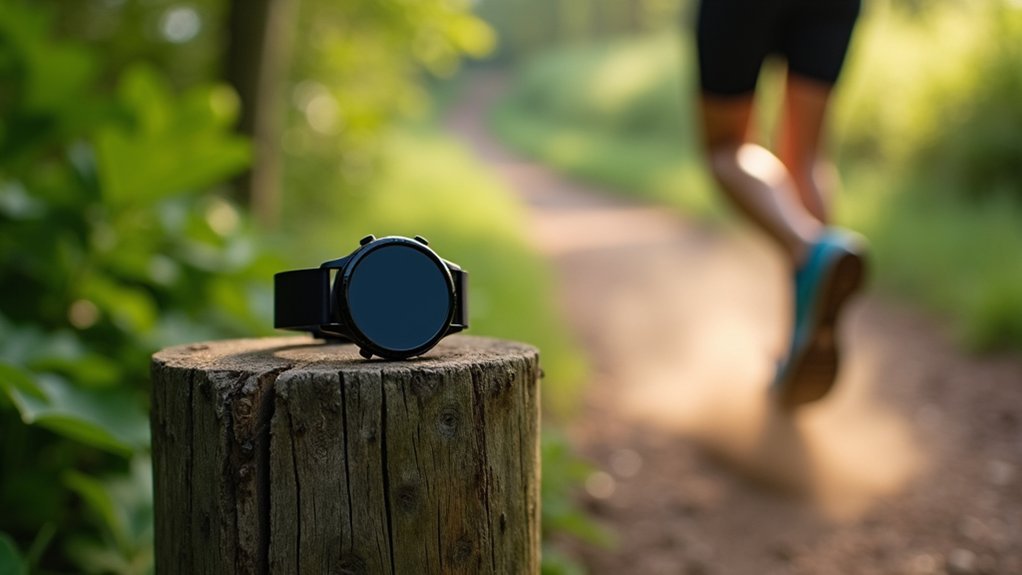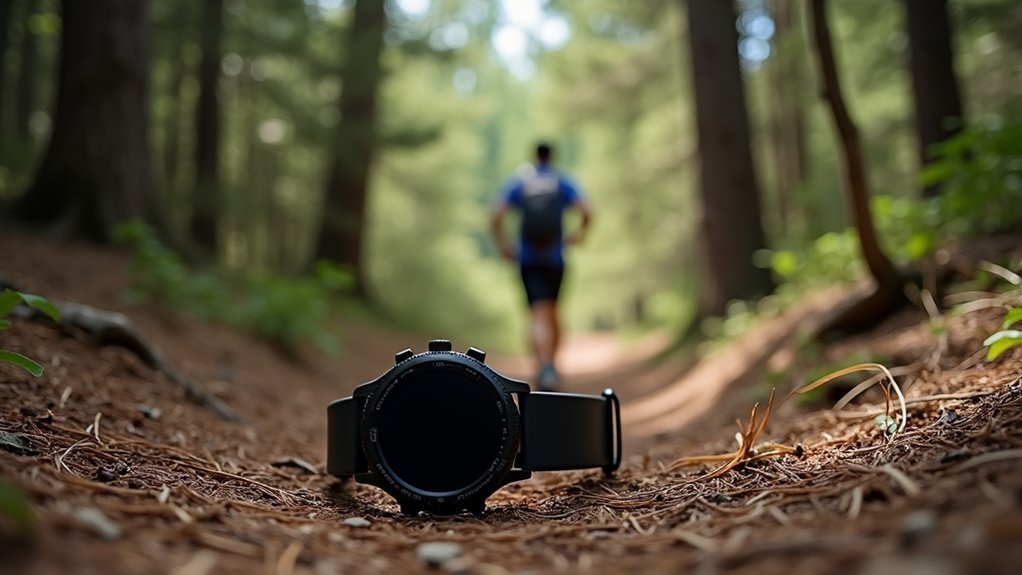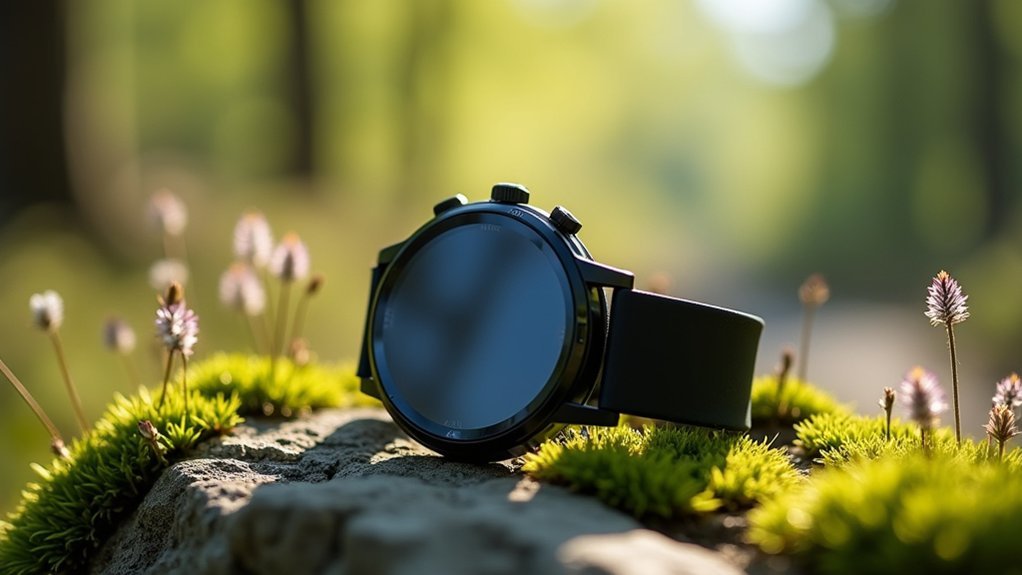Your trail smartwatch shows incorrect pace due to GPS challenges in dense forests, rocky terrain causing signal bouncing, and tight switchbacks that confuse tracking algorithms. Technical limitations exist even in premium watches, with processing delays when measuring multiple metrics simultaneously. You’ll see better results by enabling multi-constellation tracking, using 1-second recording intervals, and considering external footpods. The solutions below will transform your trail running data accuracy.
Dense Tree Cover: How Canopy Disrupts GPS Signals

While running through dense forests might offer scenic beauty and shade, it creates significant challenges for your trail smartwatch’s GPS functionality.
Tree trunks physically block satellite signals, while leaves and branches absorb and scatter them before they reach your device.
Dense forest vegetation creates a natural barrier, absorbing, scattering and blocking satellite signals on their journey to your device.
The denser the canopy, the worse your GPS performance becomes. Thick forest cover forces your watch to work with fewer visible satellites and weaker signals. Studies have shown that recreational-grade GPS receivers typically yield 5-20 m accuracy in forested environments.
This directly impacts how accurately your position gets tracked. Your watch struggles to maintain consistent connections, causing delays between position updates and creating those frustrating gaps in your route tracking.
When signals finally penetrate the canopy, they’re often so degraded that your watch calculates positions with much larger error margins than it would in open terrain.
The Multipath Error Problem on Rocky Trails
Unlike the uniform canopy issues in forests, rocky trails present a more chaotic GPS challenge known as multipath error.
When you’re running on rocky terrain, GPS signals bounce off stone surfaces before reaching your smartwatch, creating confusing signal patterns. Your watch struggles to determine which signal is direct and which is reflected, leading to inaccurate pace readings.
This problem worsens in narrow canyons or areas with large boulders that can both reflect signals and block satellite views.
Different watches handle these challenges with varying success. Some use advanced smoothing algorithms to filter out erratic readings, while antenna design and signal processing capabilities also play significant roles. Fitness watch manufacturers like Garmin and Suunto focus on developing proprietary algorithms that enhance raw GPS data for better accuracy in challenging environments.
Remember that rapid altitude changes common on rocky trails further compound these accuracy issues.
Instant vs. Average Pace: Understanding the Critical Difference

When trail runners glance at their watches during a run, they’re often confronted with two distinctly different metrics: instant pace and average pace. Understanding this difference is essential for accurate interpretation of your performance data.
Instant pace captures your speed at a specific moment, updating rapidly and fluctuating with terrain changes, while average pace calculates your overall speed since starting. Your instant pace will jump dramatically on technical trails due to GPS variability and momentary speed changes, creating frustrating inaccuracies. Clear communication of processing status helps users understand why their watches may temporarily show unreliable data.
For trail running, average pace typically provides a more reliable indicator of your performance, especially during longer efforts.
Consider customizing your watch display to show both metrics—use average pace to track overall progress and instant pace selectively when monitoring immediate effort changes on stable terrain.
Why Your Premium Watch Still Gets It Wrong
Despite investing in a high-end trail running watch, you’ve likely experienced frustrating pace inaccuracies that undermine your training efforts. Even premium models like Apple Watch Ultra, Garmin Forerunner 955, and Amazfit devices struggle with reliable pace data.
The premium price tag on your running watch doesn’t guarantee accurate pace data—a frustrating reality for serious trail runners everywhere.
The culprits are numerous: GPS signal interference from buildings or dense forest canopies corrupts your data. Hardware limitations persist across all brands—even those with dual GPS capabilities.
Software glitches introduced through firmware updates can unexpectedly worsen performance rather than improve it. Garmin’s recent switch from average pace to current pace on workout displays has particularly impacted training quality.
What’s particularly disheartening is that proper settings optimization and careful calibration might improve accuracy but won’t eliminate these issues entirely. Premium doesn’t guarantee precision when environmental factors intervene.
These persistent inaccuracies create a significant gap between user expectations and actual performance, potentially derailing your carefully planned training sessions.
Switchbacks and Sharp Turns: A GPS Nightmare

Trail running’s most technical features create the perfect storm for GPS inaccuracy. When you hit switchbacks, your watch simplifies your zigzag path into straight lines, underestimating distance and making your pace appear faster than reality.
- GPS samples intermittently to save battery, missing the full shape of tight turns.
- Your watch assumes straight-line movement between GPS points, “cutting corners” on switchbacks.
- Dense tree cover and steep terrain block and reflect signals, causing position errors.
- Multipath effects from cliff faces and rocks create false readings exactly where accuracy matters most.
The tighter and more frequent the switchbacks, the worse these problems compound. Consumer-grade GPS devices typically have 3-meter accuracy at best, which compounds the switchback tracking issues.
Your premium watch isn’t defective—it’s battling physics limitations while trying to track your complex movements through challenging environments.
The Truth About Smartwatch Antenna Limitations
While switchbacks create external GPS tracking challenges, the core hardware inside your smartwatch plays an equally important role in pace accuracy problems.
Your device faces fundamental physical constraints: GPS signals have specific wavelengths (19.05cm for L1 band), but watch size limits ideal antenna dimensions.
When you run, your watch antenna struggles against multiple barriers. The human body absorbs power and detunes the antenna, while your wrist movement creates inconsistent signal reception. Interestingly, the metal bezel may actually function as the antenna in some watch models like the Fenix 6 series.
Even watch placement matters—wearing it on your inner wrist greatly reduces accuracy.
Newer dual-band GPS watches face additional complexity, as they must effectively capture both L1 (19.05cm) and L5 (25.48cm) wavelengths in a tiny form factor.
These hardware limitations explain why your trail pace readings fluctuate dramatically, sometimes showing errors of hundreds of meters even on standard tracks.
How Elevation Changes Confuse Your Device
When you tackle mountainous trails with your smartwatch, elevation changes create a perfect storm of pace calculation errors. Your device struggles to differentiate between vertical and horizontal movement, especially on steep terrain where barometric sensors and GPS signals conflict.
Most watches miscalculate your pace during elevation changes because:
- GPS signals weaken in mountainous terrain, causing position errors of up to 400 feet
- Barometric altimeters drift with weather changes, introducing additional inaccuracy
- Devices don’t properly account for slope in their pace algorithms
- Sensor fusion systems get confused when climbing or descending rapidly
The steeper the trail, the less accurate your pace reading becomes.
As gradient increases, pace accuracy plummets—turning your precision smartwatch into little more than a glorified stopwatch.
Even high-end watches with barometric altimeters show 1.3-1.7% error rates on hilly segments compared to just 0.4% on flat paths. Frequent calibration of altimeters using known elevation points can significantly improve pace calculations during elevation changes.
When Algorithms Fail: Software Limitations Explained
Your smartwatch’s pace calculation struggles because its smoothing algorithms can trap pace data in an endless cycle of corrections, removing critical information about your actual speed changes on the trail.
These processing bottlenecks occur when your device receives GPS points faster than it can meaningfully analyze them, resulting in delayed or inaccurate pace readings.
The software fundamentally makes compromises between responsiveness and stability, often prioritizing clean-looking data over the accurate representation of your variable trail efforts. This issue becomes especially pronounced when running on trails with overhead cover that significantly impacts GPS accuracy.
Smoothing Traps Pace Data
Although designed to provide cleaner data, pace smoothing algorithms often trap runners in a misleading representation of their actual performance.
Your watch’s real-time pace readout is actually a delayed average, not your instantaneous speed, creating a lag effect that masks sudden changes in effort.
This algorithmic smoothing creates several problems on trails:
- Your watch shows pace updates 5-10 seconds after you’ve changed speeds, making interval training frustratingly inaccurate
- Sharp turns and elevation changes confuse algorithms designed for straight paths
- Over-smoothing hides the true intensity of your trail efforts
- Sensor fusion can prioritize cadence data over GPS, introducing artificial pace fluctuations
Trail running amplifies these issues, as winding paths and variable terrain challenge even the best smoothing techniques, leaving you with pace data that doesn’t match your perceived effort. Premium models like the Coros Vertix 2S with its sapphire glass display offer better durability for trail running, but even they struggle with pace accuracy in challenging terrain.
Processing Pipeline Bottlenecks
Beneath the sleek interfaces of trail smartwatches lies a complex processing pipeline where numerous bottlenecks can sabotage your pace data.
When your watch encounters high processor loads from tracking multiple metrics simultaneously, GPS data processing gets delayed.
Your watch must synchronize various data streams—GPS, heart rate, and motion sensors—before calculating pace, creating latency that’s particularly noticeable on technical trails.
The algorithms prioritize battery efficiency over real-time updates, especially during GPS signal loss.
Most watches rely on post-processing and data buffering that work well for consistent road running but falter on variable terrain.
These computational limitations become apparent when you’re maneuvering through switchbacks or steep grades exceeding 20%, where proprietary pace metrics (NGP, GAP) struggle to accurately model your effort against changing conditions. This problem exists because traditional GAP formulas like Strava’s rely on non-individualized averages rather than personalized data for each athlete.
External Footpods: Are They Worth the Investment?
When trail runners struggle with unreliable pace data from their GPS watches, many consider adding an external footpod to their gear arsenal.
These small devices can provide more consistent instantaneous pace data than GPS in challenging trail conditions, especially when satellite signals degrade in dense forests or on twisty routes.
- First-generation footpods require calibration per shoe but achieve 98-99% accuracy when properly set up.
- Second-generation footpods like Stryd use 9-axis sensors for improved accuracy without calibration.
- Footpods deliver valuable running dynamics metrics including cadence, stride length, and ground contact time.
- They work reliably indoors and in GPS-challenged environments, serving as an excellent backup system.
The Garmin Pod specifically shows limitations for trail running due to its fixed calibration factor, making it less suitable than alternatives like Stryd or Stryd Live for variable terrain.
The investment brings additional costs and another device to maintain, but for serious trail runners seeking consistent pace data and detailed metrics, footpods offer compelling benefits.
Proper Satellite Lock: What Most Runners Skip
Why do so many trail runners experience erratic pace data? The culprit is often impatience with satellite lock. When you activate your watch, it needs time to connect with multiple satellite constellations (GPS, GLONASS, Galileo) for accurate positioning.
You’re likely starting your run too quickly after turning on your watch. Without a full satellite lock, your device can’t accurately calculate pace. This problem worsens in challenging trail environments where dense foliage, mountains, and narrow valleys already obstruct signals.
For better pace accuracy, turn on your watch in an open area 2-3 minutes before starting your run. Remain relatively still during this process. Modern GPS watches like the Garmin Forerunner 965 provide significantly improved accuracy with their multi-band GPS satellite recording technology.
Watches supporting multiple satellite systems perform better on trails, particularly in dense forests where signal quality deteriorates rapidly.
Optimizing Watch Settings for Maximum Trail Accuracy
Many trail runners never achieve reliable pace data simply because they haven’t optimized their smartwatch settings. For technical terrain, your configuration choices dramatically impact accuracy.
- Enable multi-constellation satellite tracking (GPS+GLONASS) to improve signal in tree-covered areas.
- Activate 3D speed and distance calculations to account for vertical movement on hills.
- Set GPS recording to 1-second intervals rather than “smart recording” for consistent data.
- Disable auto-pause features that can confuse pace calculations on technical terrain.
Remember to manage power wisely by reducing backlight brightness and unnecessary features like vibration alerts. While waiting for your watch to establish satellite connection, maintain patience as the verification process is ongoing.
For extremely technical trails, consider pairing a foot pod like Stryd to complement satellite data and correct GPS errors when satellite visibility is compromised.
Frequently Asked Questions
Will My Smartwatch Pace Accuracy Improve During Winter When Trees Lose Leaves?
Yes, your smartwatch’s pace accuracy will likely improve in winter when trees lose leaves. You’ll experience better satellite connectivity and reduced signal interference, though terrain challenges will still affect your readings somewhat.
How Does Running Cadence Affect GPS Pace Calculations on Trails?
Your running cadence affects GPS pace calculations when devices use step frequency to estimate stride length. On trails, this relationship becomes less reliable as varied terrain naturally alters your stride length despite consistent cadence.
Can Cold Temperatures Impact My Watch’s GPS Signal Strength?
Cold temperatures won’t directly affect your GPS signal strength. What you’re likely experiencing is battery drain or display lag. Your watch’s GPS receiver functions well below freezing, though keeping it close to your body helps maintain performance.
Does Battery Level Affect GPS Accuracy and Pace Readings?
Your watch’s battery level doesn’t directly affect GPS accuracy until it becomes critically low (below 5-10%). While your device may enter power-saving modes at low battery, pace readings typically remain reliable during normal operation.
How Do Different Wrist Sizes Influence Smartwatch Pace Accuracy?
Your wrist size affects pace accuracy through sensor contact quality. Tighter fits guarantee better readings, while loose watches create movement errors. Larger wrists may experience more skin movement, introducing additional accelerometer inaccuracies during activity.
In Summary
You’ll never get perfect pace readings on trails. Dense canopy, switchbacks, and multipath errors all undermine GPS accuracy. Don’t expect your premium watch to solve these fundamental limitations. Instead, understand the difference between instant and average pace, optimize your settings, guarantee proper satellite lock, and consider a footpod for critical training. With these adjustments, you’ll get the most accurate data possible from your trail smartwatch.





Leave a Reply